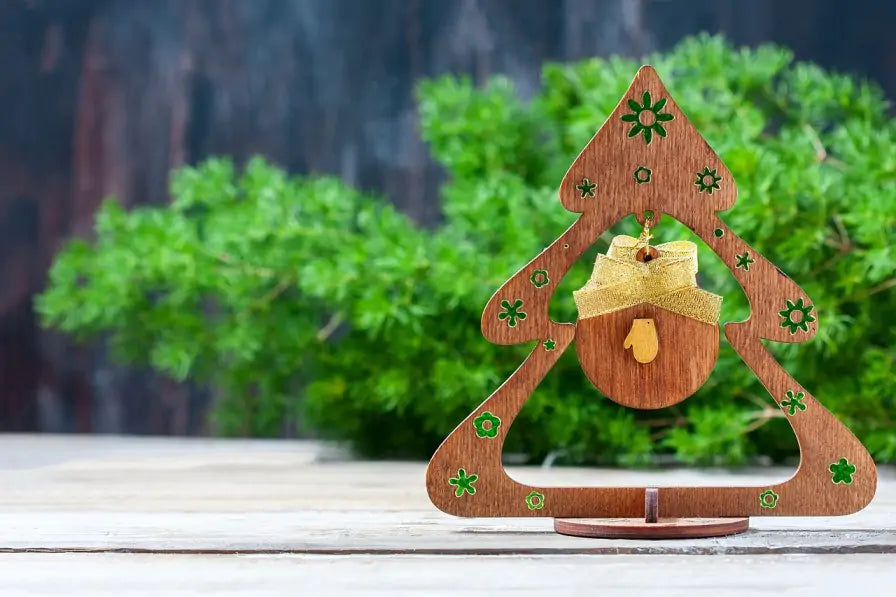Your basket is currently empty.
Shop NowChristmas Tree Recycling 2022

Christmas Tree Recycling 2022
Christmas is a time for indulgence, and while it’s a lot of fun, this time of year sure does create a lot of waste. From the 1 billion Christmas cards we throw in the bin, to the hundreds of thousands of tonnes of plastic waste we create, it all puts a strain on the planet as well as on our pockets.
Even the Christmas tree, one of the ultimate symbols of the festive season, adds to the waste burden. We throw away around 250 tonnes of real Christmas trees each year in the UK alone which results in a huge amount of waste being sent to landfill. So what can we do about this?
We can make a more sustainable choice when it comes to our Christmas tree. But is a real Christmas tree really that much better than an artificial one?
Real vs Fake: Which Christmas tree should I choose?
We see this debate every year, but which is a better choice for the environment when it comes to Christmas tree recycling? The short answer is - A properly disposed of real Christmas tree. The longer answer and the ifs, buts, and maybes are below.
Real Christmas trees
The first starting point is a real Christmas tree around 2m tall that has no roots and is disposed of in a landfill is estimated to have a carbon footprint of 16kg of carbon dioxide. Where this changes massively is if the tree has roots and you replant it at the end of Christmas, put it on a bonfire, or have the tree chipped. If you do this then the estimated carbon footprint is now just 3.5kg of carbon dioxide.
Every year around 7 million real Christmas trees are bought by UK households. With a real tree, there’s no manufacturing process involved in growing real trees and they are completely recyclable. Trees do have to be cut down, but they are often grown in sustainable forests cultivated for that purpose. If you buy a tree from a local grower, once trees are cut down they are usually replanted, and what’s more, you’re contributing to the local economy.
Choosing a real Christmas tree
Choose a locally grown tree rather than one that’s been transported many miles from Europe to help cut down on carbon emissions. You’ll also likely get a tree that looks healthier for longer this way too. A real tree should last somewhere around four weeks; if it’s starting to look a little worse for wear before then, put it outside and keep it in water. If you visit Forestry England’s website, you can find sustainably grown trees near where you live. If you’re in Scotland, go to caringchristmastrees.com all trees from here are grown sustainably on farms and a donation from every tree sold goes to a homeless charity. It’s a win-win!
Why not rent a real Christmas tree?
If you want a sustainable Christmas tree that’s also super convenient for you, why not rent a real Christmas tree? Trees are grown throughout the year and are then potted with their root ball intact (the bundle of roots you’ll find on any tree or plant) so they can be returned and replanted for next Christmas. All you have to do once Christmas is over is remove your lights and baubles and either arrange for the tree to be collected or take it back to where you rented it from. If you’re interested in renting a real Christmas tree, visit loveachristmastree.co.uk
Buy your very own living Christmas tree
If you fancy having a real Christmas tree with a virtual lifetime guarantee, why not invest in a pot-grown real living Christmas tree that you can have in your garden and use for many Christmases to come? Remember that living trees shouldn’t be kept indoors for any longer than around 1-2 weeks, and if your tree looks a little less than healthy in that time, put it outdoors in some water. You can find living trees here pinesandneedles.com

How to recycle a real Christmas tree
- If you rented your Christmas tree, simply return it or arrange for it to be collected so it can be used again next Christmas.
- If you opted for a living tree, you can replant and re-pot your Christmas tree to your heart’s content. For an added bonus for the environment, why not hang a bird feeder on it so they get some benefit at cold times of the year when food is scarce?
- If you bought a real Christmas tree and want to dispose of it responsibly, recycle it. Christmas trees can be recycled and turned into compost or wood chippings that can be spread over local parks or woodlands. Some councils offer a real Christmas tree collection service; check your council’s website to see if this applies in your area. If your council doesn’t provide this service, you can always take your tree to a local recycling centre.
- If you have a real fireplace and you fancy yourself as a bit of a woodsman, you can chop up your real Christmas tree and use it for firewood. Burning your tree actually has much less of an impact on the environment than sending it to landfill. This is because, on a landfill, it would give off methane gas as it decomposes, and burning it gives off carbon dioxide which is less harmful to the environment.
Artificial Christmas trees
Ok so onto the artificial trees, The Carbon Trust estimates that an artificial Christmas tree standing at 2m tall has a carbon footprint of around 40kg of carbon dioxide. Artificial trees are usually made from a mix of plastics so they can’t be recycled. They can last a few good years if you want them to, but more often than not, they end up in landfill, leaching toxins into the soil and groundwater.
But if you do want an artificial tree and don’t want to add to the amount of waste in landfill, why not look in charity shops or on sites like Freecycle, where you can give a second-hand tree a new home?
The recent trend with artificial trees however has been to buy them with lights already fitted, the problem with this is it significantly reduces the lifespan of the tree as the lights will develop a fault before the structure of the tree does. This increases the carbon footprint as the tree will have to be replaced on average every 4 years instead of the average of 9 years without lights being pre-installed.
How to recycle an artificial Christmas tree
The bad news is artificial trees are usually made from a mixture of materials (metal and plastics) and can’t be recycled. But you still have options when it comes to saving your artificial Christmas tree from landfill.
Store it well
An artificial Christmas tree can last a good few Christmases if you look after it and store it correctly. Keep it in its original box if you can, away from any damp.
Donate or sell it
If your tree is still in good condition, but you just fancy an upgrade, donate your unwanted tree to a charity shop, give it to a friend or family member, or list it for sale on an online marketplace.
Upcycle it
Rather than condemning your tree to a landfill site, why not cut the branches and make them into garlands or wreaths? There’s no better time than Christmas to get crafty and creative, and you’ll save on buying new decorations too!
When it comes to recycling at Christmas, there are some simple ways you can cut down on what you send to landfill, and recycling your Christmas tree is a great start. Whether you go real or fake, there are plenty of ways you can save it from landfill and give the planet an early Christmas present this festive season.
Some facts at a glance
- A real, properly disposed of Christmas tree has a carbon footprint of 3.5kg of carbon dioxide
- A real Christmas tree that is taken to landfill has a carbon footprint of 16kg of carbon dioxide
- An artificial tree has a carbon footprint of 40kg of carbon dioxide
- The average lifecycle of an artificial tree with no lights built in is 9 years before its replaced.
- The average lifecycle of an artificial tree with lights built in is 4 years.
- 7 million real Christmas trees are bought by UK households each year.
- 250 tonnes of real Christmas trees are thrown away in landfills every year.
So to sum it all up, is a real Christmas tree more environmentally friendly than an artificial tree? If it is disposed of carefully then for 90% of people it will be.






